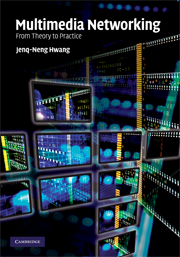Refine search
Actions for selected content:
6778 results in Communications and signal processing
10 - Analysis of LR-based MIMO detection
-
- Book:
- Optimal Combining and Detection
- Published online:
- 05 July 2014
- Print publication:
- 28 January 2010, pp 280-294
-
- Chapter
- Export citation
6 - Optimal combining: multiple-signal
-
- Book:
- Optimal Combining and Detection
- Published online:
- 05 July 2014
- Print publication:
- 28 January 2010, pp 143-175
-
- Chapter
- Export citation
2 - Fundamentals of detection theory
-
- Book:
- Optimal Combining and Detection
- Published online:
- 05 July 2014
- Print publication:
- 28 January 2010, pp 10-48
-
- Chapter
- Export citation
4 - Optimal combining: single-signal
-
- Book:
- Optimal Combining and Detection
- Published online:
- 05 July 2014
- Print publication:
- 28 January 2010, pp 79-105
-
- Chapter
- Export citation
7 - Multiple signal detection in vector space: MIMO detection
-
- Book:
- Optimal Combining and Detection
- Published online:
- 05 July 2014
- Print publication:
- 28 January 2010, pp 176-216
-
- Chapter
- Export citation
9 - Lattice-reduction-aided MIMO detection
-
- Book:
- Optimal Combining and Detection
- Published online:
- 05 July 2014
- Print publication:
- 28 January 2010, pp 246-279
-
- Chapter
- Export citation
3 - Fundamentals of estimation theory
-
- Book:
- Optimal Combining and Detection
- Published online:
- 05 July 2014
- Print publication:
- 28 January 2010, pp 49-78
-
- Chapter
- Export citation

Digital Television Systems
-
- Published online:
- 28 January 2010
- Print publication:
- 19 March 2009

Multimedia Networking
- From Theory to Practice
-
- Published online:
- 26 January 2010
- Print publication:
- 16 April 2009
Preface
-
- Book:
- Compression for Multimedia
- Published online:
- 05 June 2012
- Print publication:
- 24 December 2009, pp ix-x
-
- Chapter
- Export citation
3 - Elements of rate-distortion theory
-
- Book:
- Compression for Multimedia
- Published online:
- 05 June 2012
- Print publication:
- 24 December 2009, pp 42-65
-
- Chapter
- Export citation
4 - Scalar quantization with memory
-
- Book:
- Compression for Multimedia
- Published online:
- 05 June 2012
- Print publication:
- 24 December 2009, pp 66-90
-
- Chapter
- Export citation
Contents
-
- Book:
- Compression for Multimedia
- Published online:
- 05 June 2012
- Print publication:
- 24 December 2009, pp vii-viii
-
- Chapter
- Export citation
A - Lossless-coding techniques
-
- Book:
- Compression for Multimedia
- Published online:
- 05 June 2012
- Print publication:
- 24 December 2009, pp 238-260
-
- Chapter
- Export citation
Frontmatter
-
- Book:
- Compression for Multimedia
- Published online:
- 05 June 2012
- Print publication:
- 24 December 2009, pp i-vi
-
- Chapter
- Export citation
10 - Audio-coding standards
-
- Book:
- Compression for Multimedia
- Published online:
- 05 June 2012
- Print publication:
- 24 December 2009, pp 223-237
-
- Chapter
- Export citation
References
-
- Book:
- Compression for Multimedia
- Published online:
- 05 June 2012
- Print publication:
- 24 December 2009, pp 261-264
-
- Chapter
- Export citation
9 - Video-coding standards
-
- Book:
- Compression for Multimedia
- Published online:
- 05 June 2012
- Print publication:
- 24 December 2009, pp 197-222
-
- Chapter
- Export citation
6 - Filter banks and wavelet filtering
-
- Book:
- Compression for Multimedia
- Published online:
- 05 June 2012
- Print publication:
- 24 December 2009, pp 110-140
-
- Chapter
- Export citation
Index
-
- Book:
- Compression for Multimedia
- Published online:
- 05 June 2012
- Print publication:
- 24 December 2009, pp 265-269
-
- Chapter
- Export citation
